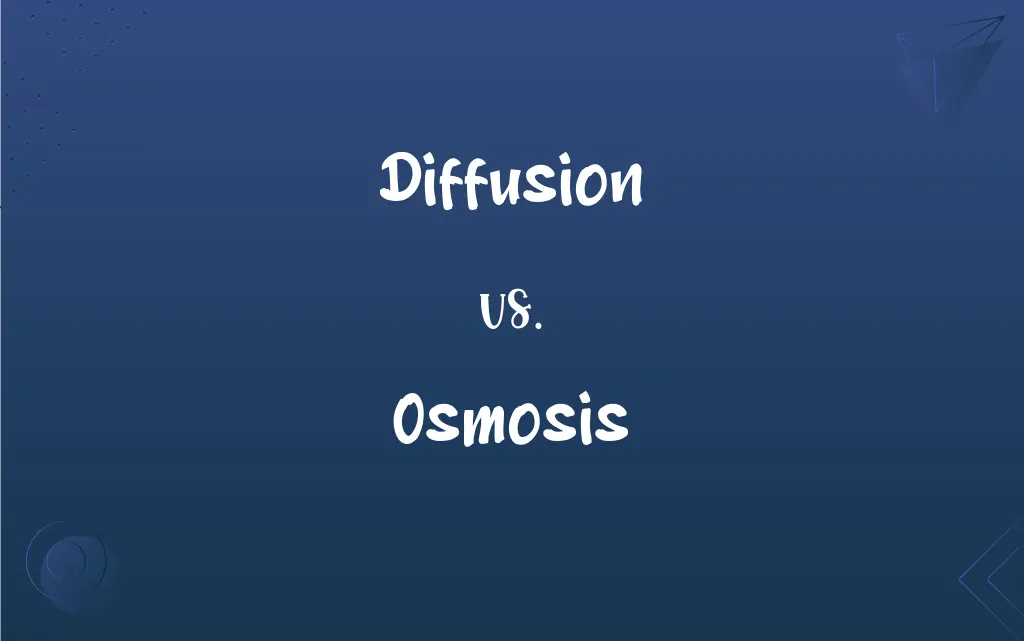Diffusion vs. Osmosis: What's the Difference?
Edited by Aimie Carlson || By Harlon Moss || Updated on October 11, 2023
Diffusion is a movement of molecules from high to low concentration without a semi-permeable membrane. Osmosis is a movement of water through a semi-permeable membrane from a region of low solute concentration to high.

Key Differences
Diffusion is the process through which molecules move from an area of high concentration to an area of low concentration. This is a basic principle of molecular movement. Osmosis, however, is specifically about the movement of water across a semi-permeable membrane.
Osmosis only involves water, moving towards an area of higher solute concentration through a semi-permeable membrane. Diffusion, in contrast, can involve any kind of molecules moving along the concentration gradient, not necessarily through a membrane.
Diffusion can occur in any mixture, including gases and liquids, without requiring a membrane. It happens in every medium where particles move freely. Osmosis is exclusively a phenomenon observed when a semi-permeable membrane separates two aqueous solutions.
Osmosis has crucial roles in biological systems, like nutrient uptake and waste removal in cells. Diffusion is universally applicable, occurring in various contexts, like spreading of perfume through the air, not restricted to biological systems.
Comparison Chart
Type of Molecules
Can involve any type of molecules
Involves only water molecules
ADVERTISEMENT
Membrane Requirement
Does not require a membrane
Requires a semi-permeable membrane
Concentration Gradient
From high to low concentration
From low solute concentration to high
Medium
Can occur in gases and liquids
Occurs in liquids, especially in water
Biological Relevance
Universal, not only biological
Predominantly relevant in biological contexts
Diffusion and Osmosis Definitions
Diffusion
The spreading of something more widely.
The diffusion of technology has benefits and drawbacks.
ADVERTISEMENT
Osmosis
The tendency of a fluid, usually water, to pass through a semi-permeable membrane into a solution.
The cucumber became plump due to osmosis in the saltwater solution.
Diffusion
The intermingling of substances by the natural movement of their particles.
The diffusion of smoke in a room occurs quickly.
Osmosis
The movement of water from an area of low solute concentration through a membrane to an area of high solute concentration.
Osmosis in red blood cells can be observed under hypotonic solutions.
Diffusion
The dissemination of elements of one culture to another culture.
The diffusion of Japanese anime globally is noticeable.
Osmosis
A gradual, often unconscious process of assimilation or absorption.
He learned French by osmosis while staying in Paris.
Diffusion
The state of being spread out or transmitted, especially of light.
Diffusion of sunlight through the clouds created a beautiful scene.
Osmosis
The process by which molecules pass through a semi-permeable membrane from a less concentrated solution into a more concentrated one.
Osmosis is vital for nutrient uptake in plant roots.
Diffusion
In physics, the process of diffusing; state of being diffused.
In the experiment, the diffusion rate of the gas was measured.
Osmosis
A process of gradual or unconscious assimilation of ideas.
Learning through osmosis is a concept often used metaphorically in education.
Diffusion
The process of diffusing or the condition of being diffused
The diffusion of new technology around the world.
Osmosis
Diffusion of fluid through a semipermeable membrane from a solution with a low solute concentration to a solution with a higher solute concentration. Osmosis ceases when there is an equal solute concentration on both sides of the membrane.
Diffusion
The scattering of incident light by reflection from a rough surface.
Osmosis
The tendency of fluids to diffuse in such a manner.
FAQs
What is diffusion?
Diffusion is the movement of particles from an area of high concentration to an area of low concentration.
Does diffusion require energy?
No, diffusion is a passive process that does not require energy.
What is "hypertonic"?
A hypertonic solution has a higher solute concentration compared to another solution.
What factors affect diffusion rate?
Temperature, particle size, and concentration gradient impact diffusion rates.
What is "hypotonic"?
A hypotonic solution has a lower solute concentration compared to another solution.
How is osmosis vital for cells?
Osmosis helps regulate the internal environment of cells by controlling the movement of water.
What is a real-world example of diffusion?
Perfume spreading throughout a room is an example of diffusion.
What is the diffusion equation?
J = -D*(dc/dx), where J is flux, D is the diffusion coefficient, and dc/dx is the concentration gradient.
Is osmosis a type of diffusion?
Yes, osmosis is a specific type of diffusion involving solvent molecules and a semi-permeable membrane.
Is diffusion random?
Yes, the movement of particles during diffusion is random.
What is "facilitated diffusion"?
Facilitated diffusion involves carrier proteins to move substances across membranes.
Can diffusion be stopped?
It continues until equilibrium is reached, with equal concentrations in all areas.
What happens to a cell in a hypertonic solution?
In a hypertonic solution, a cell will lose water and may shrivel.
Does diffusion happen in living organisms?
Yes, diffusion is vital in processes like gas exchange in lungs.
What is osmosis?
Osmosis is the movement of solvent molecules through a semi-permeable membrane from a region of lower solute concentration to higher.
What is a “semi-permeable membrane”?
A membrane that allows certain particles to pass through while blocking others.
What is "isotonic" in the context of osmosis?
Isotonic means two solutions have equal solute concentrations, causing no net movement of water.
Is diffusion limited to specific states of matter?
No, diffusion can occur in gases, liquids, and even solids.
What is "osmotic pressure"?
Osmotic pressure is the pressure exerted by the movement of water via osmosis.
What is reverse osmosis?
Reverse osmosis uses pressure to move solvent molecules from a high concentration to a low concentration through a membrane.
About Author
Written by
Harlon MossHarlon is a seasoned quality moderator and accomplished content writer for Difference Wiki. An alumnus of the prestigious University of California, he earned his degree in Computer Science. Leveraging his academic background, Harlon brings a meticulous and informed perspective to his work, ensuring content accuracy and excellence.
Edited by
Aimie CarlsonAimie Carlson, holding a master's degree in English literature, is a fervent English language enthusiast. She lends her writing talents to Difference Wiki, a prominent website that specializes in comparisons, offering readers insightful analyses that both captivate and inform.































































